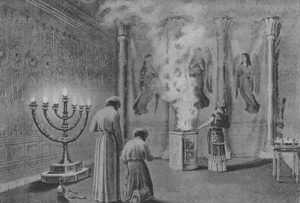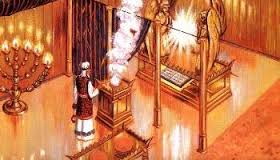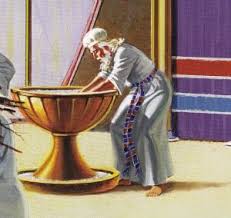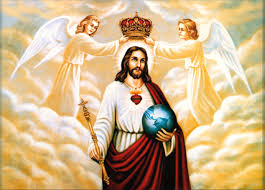We’ve been studying Hebrews, and the last post was Hebrews 8. In Chapter 8 the author of Hebrews explained that the Tabernacle and the laws were a copy and shadow of the better things to come, that is Christ and the new Covenant. He concluded that the Old Covenant was obsolete, destined to pass away, while the New Covenant was fitting for our sin and God’s love, and it was permanent. The author spends lots of time comparing and contrasting things, and proving through scripture that Christ’s sacrifice and priesthood were necessary. In chapter 9 he continues to describe the Old Covenant and Old Testament Law and sanctuary. Let’s read:
Now the first covenant had regulations for worship and also an earthly sanctuary. 2 A tabernacle was set up.
The author begins to describe the tabernacle. Tabernacle means, a tent or hut. The Hebrew term “mishkan” meant dwelling place or residence. As we mentioned last time, this is an earthly copy of something above, and it represents where God resides, dwells, or lives. His presence would be found there, so this is basically the place for the Children of Israel to go in order to meet God. The only place. That makes sense that this place was called the tent of meeting; it was also called sanctuary a holy place.
In its first room were the lampstand and the table with its consecrated bread; this was called the Holy Place.
Let’s talk about the articles found in the Holy Place.
The candlestick, or Golden Lampstand, also called “The menorah” stood at the left side of the Holy Place. It was hammered out of one piece of pure gold. The fact that it was pure gold represented the purity, Deity, and perfection of God. The menorah was the only source of light in the Holy place, so there are no other ways to illuminate the tent of meeting. So this light from the menorah was used to illuminate the consecrated bread and incense. Now recall, the priests had no other way to approach God besides this very activity in the temple, The Menorah was the light that enabled the people of God to be in communion with Him. Now Just as the Golden Menorah represented purity, Deity, and perfection, it was still just a copy or shadow of true perfection. Jesus was the “True light who gives light to every man” Like the Gold, He was pure, holy, Divine. And just like the Menorah was the only way for priests to enter into communion with God, Jesus is the only way for us to have communion with God, and He is the only way we can come out of spiritual darkness.
Now this Temple Menorah isn’t like the one seen for Chanukiah. That one has four branches on each side, and one in the middle, representing the number of days the temple’s Menorah remained lit. The Temple’s Menorah has fewer branches, but is similar; The design of the Golden lampstand had a central branch from which three branches extended from each side, forming a total of seven branches. Seven is a number that represents completion and perfection. In the Bible, Six represented sin, falling short of holiness. Six represented humanity and our fallen state. The Menorah had seven lamps holding olive oil and wicks, each branch looked like that of an almond tree, containing buds, blossoms and flowers. According to Jewish customs, The central branch of the Menorah represented the light and wisdom of God, the other six represented human branches of knowledge. If the design of the Menorah is a copy and shadow of things to come like Hebrews 8 says, then that central branch represents Jesus, and we as believers are represented by the six branches that extend from original branch. Once we believe, we now live as “children of light” (Ephesians 5:8) who draw our source of light from Jesus, the true light. Jesus calls us “light of the world” and in Matthew 5:14-16 Jesus commands us to “let your light shine before men, that they may see your good deeds and praise your Father in heaven”. In addition to us being lights pointing to the true light, we are also like the branches, which serve as a picture of Jesus’ description of our relationship with him: “I am the vine, you are the branches … apart from me you can do nothing” (John 15:5).
Now let’s talk about the table with consecrated bread.
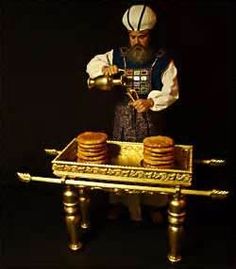
The table was on the right side of the Holy place, across from the Menorah. On it sat 12 loaves of bread, representing the 12 tribes of Israel. It remained on the table for a week and on the Sabbath, the Priests would remove it and eat it in that Holy Place. It was only eaten by priests, and it was only eaten in that Holy Place, because the bread was holy.
The bread on the table was known as consecrated bread, or “Showbread” but was also known as “bread of the presence” because it was to be always in the Lord’s presence in that Holy Place. The table and the bread were a picture of God’s willingness to fellowship and communion (literally speaking, sharing something in common) with man. But it is worth noting that the willingness was on God’s own terms. The bread had to be eaten in the Holy Place, and your sins had to be covered before entering into God’s place.. It was like an invitation to share a meal, an extension of friendship. But it wasn’t any ordinary meal, it was a special and holy meal. Eating together often is an act of fellowship. God was willing for man to enter into His presence to fellowship with Him, and this invitation was always open.
Jesus demonstrated the completion of this shadow or copy when He ate with tax collectors, prostitutes and the sinners of Jewish society. This fellowship bread was more than just a gesture of friendship on earth. Jesus came to call sinners to Him, make them right with God, to forgive them and reconcile them so that they could enjoy everlasting fellowship with God.
Jesus compared himself to the consecrated bread when he declared in John 6:35,49-50 “I am the bread of life. He who comes to me will never go hungry, and he who believes in me will never be thirsty. … Your forefathers ate the manna in the desert, yet they died. But here is the bread that comes down from heaven, which a man may eat and not die.”
God loved the World and desired fellowship with us that He was willing to come to earth from heaven as our “bread of life” to give eternal life to all those who would partake in it. At Jesus’ last Passover meal with His disciples, Jesus described Himself as bread again. In Matthew 26:26: “While they were eating, Jesus took bread, gave thanks and broke it, and gave it to his disciples, saying, ‘Take and eat; this is my body.’”
Jesus’ broken body is our only access to fellowship with God. Today when we celebrate the Lord’s Supper, or communion, we remember this important truth. And today, as in the day of Moses’ tabernacle, God still desires to have fellowship and sit down for a feast with His people
3 Behind the second curtain was a room called the Most Holy Place, 4 which had the golden altar of incense and the gold-covered ark of the covenant. This ark contained the gold jar of manna, Aaron’s staff that had budded, and the stone tablets of the covenant.
now let’s talk about the incense. First thing that I would want to mention is the location. In Exodus 30, it is clearly positioned in front of the curtain between the Holy Place and the Most Holy place. Hebrews 4 seems to state that this Altar is behind the curtain in the Most Holy place. This bothered me for a while because it looked like the Bible was inconsistent. If I believe the Bible to be truth, there shouldn’t be differences in facts or errors. So what is the deal? In Hebrews 9:2 the wording was “In its first room were the lampstand and the table”. The language is locational “In a room was these things. In Hebrews 9:3-4 the wording is different. “the Most Holy Place had the golden altar of incense.” The room has these articles, which means that these articles are associated with the room, not necessarily that they were in the room. As we learn about this Altar, we understand how this interpretation makes sense. So let’s discuss.
Four horns protruded from the four corners of the altar. God commanded the priests to burn incense on the golden altar every morning and evening, the same time that the daily burnt offerings were made. The incense was to be left burning continually throughout the day and night as a pleasing aroma to the Lord. The Most Holy Place was only to be entered once per year. So the instruction to burn incense two times daily could not be carried out if the priests needed to enter the Most Holy Place in order to tend to the Incense altar. So let’s discuss what this Incense means. The incense symbolizes the prayers and intercession of the people going up to God as a sweet fragrance. God wanted His dwelling to be a place where people could approach Him and pray to Him. Last month when I preached I mentioned how the copy or the shadow was important or else people wouldnt understand the true thing correctly. I referenced that Jesus had entered the Temple and complained that it wasn’t an accurate copy or representation of God. Remember what he said? He was quoting Isaiah 56:
In Isaiah 56:7 it says “for my house will be called a house of prayer for all nations.” God’s house was supposed to be a house of prayer. The Incense represented prayer floating or ascending up to heaven. Incense or smoke goes from earth to the heavens. The picture of prayers wafting up to heaven like incense is found multiple places in the Bible. It’s captured in David’s psalm 141 and also in John’s vision in Revelations:
“May my prayer be set before you like incense; may the lifting up of my hands be like the evening sacrifice.” (Psalm 141:2)
and also in Revelations 8:3-4:
“Another angel, who had a golden censer, came and stood at the altar. He was given much incense to offer, with the prayers of all the saints, on the golden altar before the throne. The smoke of the incense, together with the prayers of the saints, went up before God from the angel’s hand.”
Hebrews 8 says that the tabernacle is becoming obsolete, and was a symbol and copy of something greater, so the golden altar of incense must point towards something greater. Similar to the Menorah, the Golden altar of incense is a representation of Christ, who is our intercessor before God the Father. During His days on earth, Jesus prayed for the believers. He was like the high priest of the tabernacle, who bore the names of each of the Israelite tribes on his breastplate before God. Just before He was betrayed and sentenced to death, Jesus interceded for His disciples and all believers, asking God to guard them from evil and sanctify them by His Word, and that they may see God’s glory and be a witness to the world (John 17:1-26). Because Jesus didn’t stay dead, because he came back to life, to this day Jesus still is our high priest at the Father’s side, interceding for God’s people. Romans 8:34 explains this..
“Christ Jesus, who died — more than that, who was raised to life — is at the right hand of God and is also interceding for us.”
Since we have been forgiven of our sins through the blood of Christ, we also come boldly in prayer in Jesus’ name. When we pray in Jesus’ name, we are praying based on the work He has done and not on our own righteous acts or works.. It is in His powerful name that we are saved and baptized, and in His name we live, speak and act.
So Incense represents prayer. And one time per year, on the day of Atonement, the altar of incense was used a bit differently. The horns of the golden altar were sprinkled with blood from the animal sacrifice to cleanse and purify it from the sins of the Israelites (Leviticus 4:7, 16:18). Just as the horns on the brazen altar represent the power of Christ’s blood to forgive sins, the horns on golden altar signify the power of His blood in prayer as we confess our sins and ask for His forgiveness. On the Day of Atonement they used the altar of incense and the censer to make smoke of incense to conceal the ark cover so the High Priest would not die from God’s presence. We will talk about this ark cover in a bit. The Incense altar was in the holy place, but it was necessary for entry into the Most Holy place.
the ark of the covenant which contained three things. First, the gold jar of manna, representing God’s providence and his ability to feed his people. The second is the Staff of Aaron that budded, representing God’s authority, power, and strength. Third is the stone tablets of the covenant, representing God’s standards, his Laws, and His pact with his people, his Justice, and His Goodness.
5 Above the ark were the cherubim of the Glory, overshadowing the atonement cover. But we cannot discuss these things in detail now.
In Exodus 25:10-22 we read about the construction of the tabernacle and something called an ark cover. This cover is precious; it’s gold hammered out with two cherubim on either side. It’s described in length in Exodus 25:17. Like everything else in the Tabernacle, it has so much meaning. In Hebrew it’s called ha-kappōreṯ, which is derived from kapporeth, or cover. But in Greek translations hilasterion was used here. If you look at the Hebrew context of the word, kapporeth is derived from kaphar, which is often considered to mean cover, the literal meaning of kaphar is wipe out, implying that kapporeth means thing of wiping out/thing of cleansing. There’s a cognate Arabic term kaffarat is used in modern legal contexts to refer to any mechanism of rectifying illegality. If you break a law and pay a fine, that makes you right before the law. So this kaffarat is a way to take a transgression or something illegal and turn it into something right. Then if you look at the Greek Septuagent you see the word, hilasterion etymologically means thing for propitiation, with Hesychius writing that a synonym of hilasterion was thing for catharsis, while the Vulgate translates it as propitiatorium.
In some translations it’s called an ark cover. If you call it a cover, and read through it quickly, you might just think it means something that goes over something else. Like a hat to cover your head. But the both the Hebrew and Greek translations really mean a deeper version of cover, which would mean to pay for or to make atonement for a wrong. In 1 Samuel 4:4 this thing over the ark was described as a throne of God: “So the people sent to Shiloh, and brought from there the ark of the covenant of the Lord of hosts, who is enthroned on the cherubim.” God’s glory was supposed to sit on the throne of cherubim. This cover was sprinkled with blood on the day of atonement in order to cleanse the people of their sins and offer them forgiveness. So you have to think about the ark, the law, about the guilt before the law, you need to then think about the propitiation, atonement, payment for a wrong. But remember it’s not the sinner that’s paying themselves, it’s the sacrifice, so it is also forgiveness and mercy. In the 1500’s the theologian and famous translator of Scripture, William Tyndale, gives this ark cover a name that tries to encompass all meanings, but still kind of falls short. He calls it a mercy seat, or seat of grace. But its more like “God’s throne of atonement, propitiation and mercy.”
6 When everything had been arranged like this, the priests entered regularly into the outer room to carry on their ministry. 7 But only the high priest entered the inner room, and that only once a year, and never without blood, which he offered for himself and for the sins the people had committed in ignorance. 8 The Holy Spirit was showing by this that the way into the Most Holy Place had not yet been disclosed as long as the first tabernacle was still functioning.
So knowing all these things about the Holy place, and the Most holy place, and understanding the symbolism in each of the elements and the arrangement of this ritual we have everything set up exactly. The light of the menorah draws people out of darkness to fellowship with God. There is a table of bread of meeting or communion. Daily we lift prayers and intercession to God and the incense rises heavenward. The most holy place is filling up with smoke, which protects the priest from the encountering an almighty, pure, perfect face of God. A pure holiness that has been known to cause death to fools who don’t take God’s instruction seriously. The High Priest makes a sacrifice for his own sins and another for the sins of his people. Sins that are committed in ignorance. Sins that even the most high priest himself is unaware of. The tone is somber and severe. The feeling is fear and awe at such a great and unknowable Power. The holiest guy you know, he makes a sacrifice for the things he doesn’t even understand or comprehend. Verse 8. This is all pointing towards something. The Holy Spirit is showing us that even with the best study and intentions we can’t even begin to fathom God’s greatness and our undeserving state. How do you enter into the Most Holy Place? There are strict rules to follow, there is mystery, danger. God is not to be trifled with. If you do enter the Most Holy Place unprepared you may never exit there. With such a Tabernacle in operation, is there even a way to know whether you are right before God? And if so, for how long is your standing good for? Until next year’s Day of Atonement? It is all a copy or shadow that’s pointing towards something better. Read verse 9-10
9 This is an illustration for the present time, indicating that the gifts and sacrifices being offered were not able to clear the conscience of the worshiper. 10 They are only a matter of food and drink and various ceremonial washings—external regulations applying until the time of the new order.
All of these things are illustrating something for us today. Those gifts, those sacrifices were incomplete. They were temporary. They solved an issue that was superficial or cosmetic, but never were able to clear a conscience. Even after the Hebrews being given light and knowledge and wisdom, fellowship and prayer. Even after being given a propitiation or atonement, the sin and guilt returned. The next sabbath, and the 50 sabbaths after that, another offering or gift or sacrifice had to be given. And on the next year, on the next day of Atonement everything had to be done over again. The author of Hebrews concludes that the food and drink, the ceremonial washing, these are all external. The bread of fellowship left the priests hungry, the washing that had to be done before entering the holy place didn’t clean the hearts and the consciences of the people or their priestly representatives. It is all beautiful but it is symbolic of something greater which will happen in the time of the new order.
The time of an eternal priest, who is Christ. The rest of chapter 9 goes into how Jesus fulfills completes, perfects these regulations, and in light of Jesus being a priest forever, what that actually means for us as believers.
